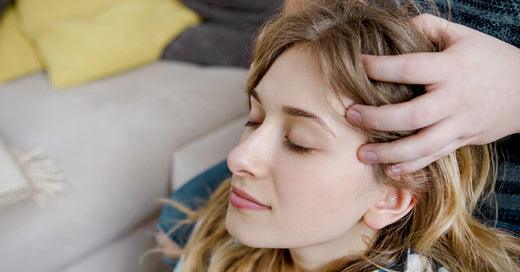While the pandemic has been difficult for many, for those who are in the business of touch, the pain of social distancing has cut a level deeper. Relying entirely on in-person, hands-on services, massage therapists saw their business wiped out entirely in the blink of an eye when social distancing became a nearly ubiquitous mandate.
While their business has been on ice, some massage therapists have already pivoted to new ventures, while others are holding the line until they can return to what they know best. Areefa Mohamed, a New York City-based massage therapist who has been practicing for 10 years now, relates all too well. She’s found herself completely out of work since the beginning of the COVID-19 pandemic. “COVID-19 has affected me as a therapist because we are not physically able to help clients or to physically work. It’s a scary time and not being able to alleviate stress and anxiety in the best way I know, through massage,” she tells Allure.
Many massage therapists like Tim Grae, a New York City-based licensed massage therapist who runs a massage therapy and recovery company, are considering the added stress of figuring out how to pay for office spaces with unclear guidance around rent allowances and small business support. It’s been a “huge struggle,” Grae says.
There’s also the new stigma of the industry to contend with. “Massage therapists, like so many others, are experiencing devastation at suddenly losing their ability to work and sustain gainful employment,” says New York City-based licensed marriage and family therapist Damon L. Jacobs. “In some echelons of American society, massage work is diminished and disrespected, as many don't understand the vital role of massage in maintaining physical and emotional wellness. When people lose their livelihood and are mocked or minimized for the services they provide, it adds an extra layer of difficulty and suffering.” Here, Allure talks with multiple professionals in the field about the future of the industry and how they’ve been dealing with the changes they’ve already had to make.
At the time of publishing, more than half of the states in the U.S. have started to allow massage businesses to reopen many with safety protocols in place, including reducing the number of clients and rigorous cleaning between each appointment. Reopening is happening now, or very soon, for massage studios in states like California, and states with high numbers of cases including New Jersey and New York will reopen in a later phase.
Trying to find new ways to make a living
New York City-based licensed massage therapist Yaddy Maldonado (who has been practicing for 11 years) is leaning on completely unrelated skills to earn income through a separate network marketing business she’s run on the side. Others reported leaning into past job experience with everything from security guard duties to digital marketing to grocery delivery to make ends meet.
Most massage therapists report that while they aren’t offering physical services, they are staying in touch with their clients. Many are hosting online classes, including on some topics that aren’t necessarily specific to massage, though they are tangentially wellness-themed.
Unlike some other industries and services that've moved to virtual appointments, it’s trickier to replace the experience of giving or receiving a massage with a Zoom class or a phone call, and some massage therapists don’t actually want to pivot their business plan. Doug Elman of Hand & Stone Massage and Facial Spa in Spring Lake, New Jersey, normally sees 25 to 35 clients a month for various massage and related services and, after 15 years in the industry, he is now on unemployment. “The spas have all shut down, so I do not see my clients,” Elman says. So far, Elman doesn’t have alternative work to supplement his income, and he’s been practicing his massage skills on his wife at home so he doesn’t get rusty. “My wife has been kind enough to be a volunteer for me,” he says.
Pivoting the business model to acknowledge the present
Some massage therapists are finding ways to keep the lights on and their central skills utilized. Austin, Texas-based Sophia Valerio has been a licensed massage therapist for nine years. While she isn’t performing the same touch-based services as she was pre-COVID-19, she still has a roster of clients including employees of corporations that are now classified as essential businesses. “I have been given the opportunity to perform wellness instruction that involves contact-free stretching instruction one-on-one through a series of stretches and soft tissue manipulation, from about 10 feet away or via video call,” she explains. And with Texas opening up earlier than most of the other states, Valerio is slowly starting to see a handful of clients in person again. It isn’t business as usual, though, as she has seen just a small number of clients compared to her pre-COVID volume, and is taking special precautions to sanitize more and limit travel to a five mile radius.
Grae has more recently started teaching movement and mobility classes online and created “Mobility Mondays,” where he uploads videos demonstrating stretches and movements targeting different areas of the body. “One thing that always gives me hope,” says Grae, “is that I grew up poor. Being out of work doesn’t frighten me because I’ve seen it before under worse conditions. I believe in options and creativity and that nothing is final.”
Others echo the idea that nothing is final, and are managing the profound loss of business with an understanding that this isn’t their time, but will be again one day.
“We are closed. The government has mandated no massage therapy. I support this decision to keep everyone safe,” says Kim Rossi, the spa director at the Art of Living Retreat Center Spa in Boone, North Carolina.
The need for touch will never go away
The irony that the benefits massage provides would be extra helpful now as people find themselves more anxious, depressed, and isolated than ever is not lost on most massage therapists.
“Today, in the middle of the COVID-19 crisis, both givers and receivers of consistent consensual touch are facing a different risk,” explains Jacobs. Research has shown that being deprived of human contact, or being “touch starved,” can affect blood pressure, heart rates, depression, and anxiety.
“Human contact is very grounding. We need connection for our wellbeing. It reduces stress. It grounds us and connects us, not only to the other, but to ourselves,” explains relationship expert and author Susan Winter. “In our busy world, we can tend to live in our heads, multi-tasking; touch in the form of massage brings us back into our body. If you deny touch, you deny a sense of belonging.”
The future of massage
Some worry that a lingering fear of touch will remain even after social distancing measures are lifted. People may not rush to pay strangers to touch them right away.
“Understandably, no one wants a massage during a pandemic, and I’m sure most therapists wouldn’t want to risk giving one,” says New York City-based licensed massage therapist Tom Meade, who has practiced massage for 26 years and normally averages 30 hours of massage for clients a week but is now entirely without work. “It’s made me somewhat uncertain about the future. When will we be allowed to work and will people be afraid of massage? There is likely to be varying levels of PTSD after this calms down,” he shares.
“I’m waiting to see the outcome of our state opening before going forward and taking sessions that are further away,” says Valerio. “We’re probably less than a month away now from figuring out if a second wave will knock us back into quarantine or if we may proceed and try to get our schedules filled again in the safest way possible. I am hopeful that the coming weeks will present different ideas and opportunities with regards to connecting with clients,” she says.




